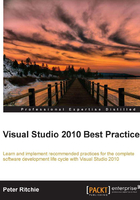
What this book covers
Chapter 1, Working with Best Practices, discusses several motivating factors about why we might want to use "recommended practices" and why we’re sometimes forced to resort to "recommended practices" rather than figure it out.
Chapter 2, Source Code Control Practices, looks at source code control terminology, architectures, and usage practices.
Chapter 3, Low-level C# Practices, looks at some low-level, language-specific practices. Topics like generics, lambdas, iterator members, extension methods, and exception handling will be detailed.
Chapter 4, Architectural Practices, looks at some architecture-specific practices. These practices will include things such as decoupling, data-centric applications, and a brief look at some recommendations for distributed architectures.
Chapter 5, Recommended Practices for Deployment, discusses installation technologies and covers some of the more common features required by the majority application installations. The chapter focuses mainly on deployment of applications through Windows Installer
Chapter 6, Automated Testing Practices, covers automated testing practices. Practices regarding test naming and structure, coverage, mocking, and types of tests will be covered.
Chapter 7, Optimizing Visual Studio, discusses ways of making Visual Studio operate more efficiently, work to our advantage, and ways to make working with Visual Studio friendlier.
Chapter 8, Parallelization Practices, discusses techniques such as threading, distributed architecture, and thread synchronization. Technologies such as Task Parallel Library, Asynchronous CTP, and asynchronous additions to C# 5.0 and Visual Basic 10 are also covered.
Chapter 9, Distributed Applications, discusses ways of architecting distributed applications, as well as specific technologies that help communication of nodes within a distributed application. In addition, it covers ways of debugging, monitoring, and maintaining distributed applications.
Chapter 10, Web Service Recommended Practices, discusses web services. It covers practices with WCF services, ASMX services, implementing services, consuming services, and authentication and authorization.